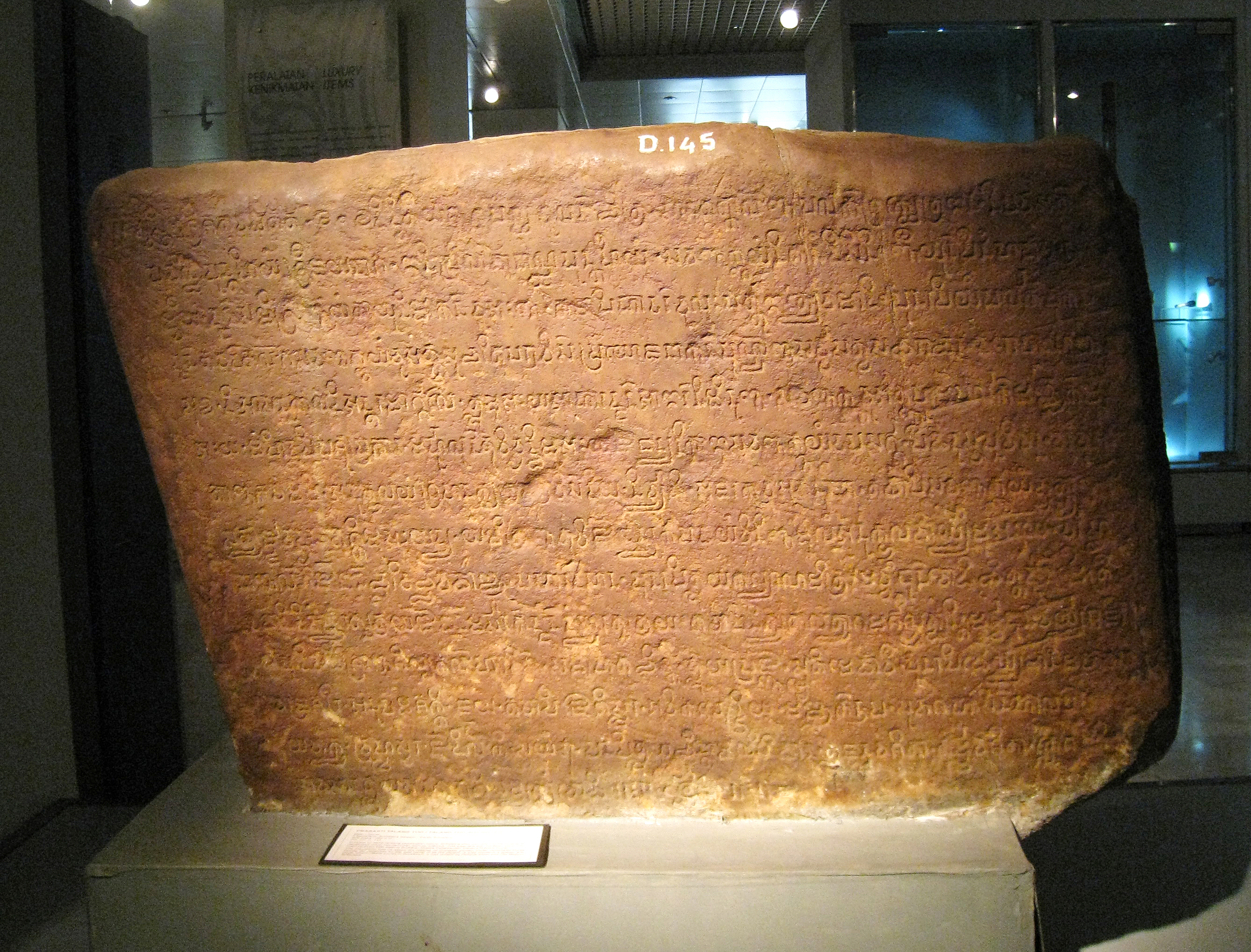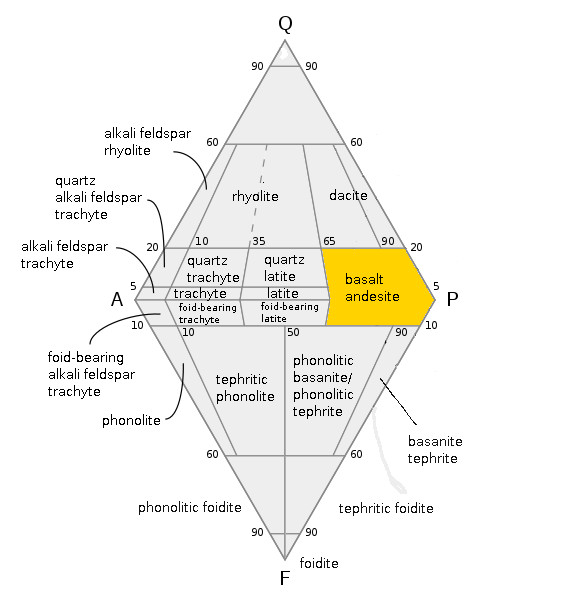|
Telaga Batu Inscription
Telaga Batu inscription is a 7th-century Srivijayan inscription discovered in Sabokingking, 3 Ilir, Ilir Timur II, Palembang, South Sumatra, Indonesia, around the 1950s. The inscription is now displayed in the National Museum of Indonesia, Jakarta, with inventory number D.155. In previous years, around thirty Siddhayatra inscriptions were discovered around Southern Sumatra, all concerning the Siddhayatra journey of Dapunta Hyang Sri Jayanasa, which, according to Kedukan Bukit Inscription took place around the year 605 Saka (683 AD). Today all of these Siddhayatra inscriptions are stored in the National Museum of Indonesia. The inscription was carved on an andesite stone measuring 118 cm tall and 148 cm wide. The top of the stone is adorned with seven nāga heads, and on the lower portion, there is some kind of water spout to channel the water that was likely poured over the stone during a ceremonial allegiance ritual. The inscription was written with Pallava letters ... [...More Info...] [...Related Items...] OR: [Wikipedia] [Google] [Baidu] [Amazon] |
Kedukan Bukit Inscription
The Kedukan Bukit inscription is an inscription discovered by the Dutchman C.J. Batenburg on 29 November 1920 at Kedukan Bukit, South Sumatra, Dutch East Indies (now Indonesia), on the banks of Tatang River, a tributary of Musi River (Indonesia), Musi River. It is the oldest surviving specimen of the Malay language, in a form known as Old Malay. It is a small stone of . This inscription is dated 1 May 683 CE. This inscription was written in Pallava script. Content Transliteration Modern Common Malay translation Indonesian translation English translation See also * Telaga Batu inscription * Kota Kapur Inscription * Talang Tuwo inscription * Laguna Copperplate Inscription * History of Indonesia * Timeline of Indonesian history Notes {{Reflist Further reading * George Coedès, ''Les inscriptions malaises de Çrivijaya'', BEFEO 1930 * J.G. de Casparis, ''Indonesian Palaeography'', Leiden (Brill) 1975. * Safiah Karim, ''Tatabahasa Dewan Edisi Baharu'', Dewan Bahasa dan ... [...More Info...] [...Related Items...] OR: [Wikipedia] [Google] [Baidu] [Amazon] |
Talang Tuwo Inscription
The Talang Tuo inscription is a 7th-century Srivijaya inscription discovered by Louis Constant Westenenk on 17 November 1920, on the foot of Bukit Seguntang near Palembang. This inscription tells about the establishment of the bountiful Śrīksetra park awarded by Sri Jayanasa the king of Srivijaya, for the well being of all creatures. The inscription was discovered in good condition with clearly inscribed scripts. Its size is 50 cm × 80 cm. It is a stone block and it is dated from 606 Saka (corresponds to 23 March 684), written Pallava script in Old Malay. The inscription consists of 14 lines. Van Ronkel and Bosch are the first scholars who translated the inscription. Their work was published in ''Acta Orientalia''. Since 1920, the inscription has been stored in National Museum of Indonesia, Jakarta, under inventory number D.145. Content The writings on the Talang Tuo inscription: Translation The translation according to George Cœdès. Old Malay vocab ... [...More Info...] [...Related Items...] OR: [Wikipedia] [Google] [Baidu] [Amazon] |
Candi Muara Takus
Muara Takus () is a Buddhist temple complex, thought to belong to the Srivijaya empire. It is situated in Kampar Regency in Riau province, Sumatra, Indonesia. Its surviving temples and other archaeological remains are thought to date to the 11th and 12th century AD. It is one of the largest and best-preserved ancient temple complexes in Sumatra. History Candi Muara Takus was constructed by the maritime-based Srivijaya Empire in the eleventh century. The architecture and design of the temples clearly indicate their Mahayana Buddhist origin. It has been suggested by Schnitger that the major temples at Muara Takus may have undergone major renovations in the twelfth century. It is thought that the area was used as both a religious and trade centre by Srivijaya. The site was abandoned for many centuries before it was rediscovered by Cornet De Groot in 1860. The site was explored and surveyed by W.P Groenveld in 1880 and excavations have been conducted periodically since. The researc ... [...More Info...] [...Related Items...] OR: [Wikipedia] [Google] [Baidu] [Amazon] |
Datuk
Datuk (or its variant Dato or Datu) is a Malay language, Malay honorific title commonly used in Brunei, Indonesia, and Malaysia, as well as a traditional title by Minangkabau people in West Sumatra, Indonesia. Use of the title various between locations, in some cases being bestowed by a ruler and in other cases being inherited by family line. The title of the wife of a male Datuk is Datin. Women with the title can take either the title Datin or Datuk. Origin The oldest historical records mentioning about the title ''datuk'' is the 7th century Srivijayan inscriptions such as Telaga Batu inscription, Telaga Batu from Palembang, Indonesia, to describe lesser kings or vassalized kings. It was called ''dātu'' in Old Malay language to describe regional leader or elder, a kind of chieftain that rules of a collection of ''kampungs'' (villages) called Kedatuan. The Srivijaya empire was described as a network or Mandala (Southeast Asian history), mandala that consisted of settlements, ... [...More Info...] [...Related Items...] OR: [Wikipedia] [Google] [Baidu] [Amazon] |
Kadatuan
''Kedatuan'' (Old Malay, Philippine, and Sundanese spelling: ''kadatuan''; Javanese romanization: ''kedaton'') were historical semi-independent city-states or principalities throughout ancient Maritime Southeast Asia in the present-day Philippines, Indonesia, and Malaysia. In a modern Indonesian/ Malay sense, they could be described as kingdoms or polities. The earliest written record mentioning the term ''kadatuan'' was the 7th-century Srivijayan Telaga Batu and Kota Kapur inscription from Sumatra, Indonesia. Etymology ''Kedatuan'' and ''kadatuan'' are derived from the root word ''datu'', which is derived from Proto-Malayo-Polynesian ''datu'', with the possible reconstructed meaning of "lineage priest". Cognates in modern Austronesian languages include ''datu'' or ''dato'' in Philippine languages; ''datu'' in Acehnese, Minangkabau, Balinese, Makassarese, Mongondow, etc.; ''datuk'' in Malay; ''rato'' in Madurese; ''ratu'' in Javanese and Sundanese; ''ratu'' or ''l ... [...More Info...] [...Related Items...] OR: [Wikipedia] [Google] [Baidu] [Amazon] |
Curse
A curse (also called an imprecation, malediction, execration, malison, anathema, or commination) is any expressed wish that some form of adversity or misfortune will befall or attach to one or more persons, a place, or an object. In particular, "curse" may refer to such a wish or pronouncement made effective by a supernatural or spirituality, spiritual power, such as a god or gods, a spirit, or a Natural phenomenon, natural force, or else as a kind of spell (paranormal), spell by magic (paranormal), magic (usually black magic) or witchcraft; in the latter sense, a curse can also be called a hex or a jinx. In many belief systems, the curse itself (or accompanying ritual) is considered to have some causative force in the result. To reverse or eliminate a curse is sometimes called "removal" or "breaking", as the Incantation, spell has to be dispelled, and often requires elaborate rituals or prayers. Types The study of the forms of curses comprises a significant proportion of the s ... [...More Info...] [...Related Items...] OR: [Wikipedia] [Google] [Baidu] [Amazon] |
Nāga
In various Asian religious traditions, the Nāgas () are a divine, or semi-divine, race of half-human, half-serpent beings that reside in the netherworld (Patala), and can occasionally take human or part-human form, or are so depicted in art. Furthermore, nāgas are also known as Dragon, dragons and Water spirit, water spirits. A female nāga is called a Nagin, or a Naiṇī Devī, Nagini. According to legend, they are the children of the sage Kashyapa and Kadru. Rituals devoted to these supernatural beings have been taking place throughout South Asia for at least 2,000 years. They are principally depicted in three forms: as entirely human with snakes on the heads and necks, as common serpents, or as half-human, half-snake beings in Hinduism and Buddhism. ''Nagaraja'' is the title given to the king of the nāgas. Narratives of these beings hold cultural significance in the mythological traditions of many South Asian and Southeast Asian cultures, and within Hinduism and Buddhism ... [...More Info...] [...Related Items...] OR: [Wikipedia] [Google] [Baidu] [Amazon] |
Dapunta Hyang Sri Jayanasa
Dapunta Hyang Sri Jayanasa () was the first Maharaja (Great King) of Srivijaya and thought to be the dynastic founder of Kadatuan Srivijaya. His name was mentioned in the series of Srivijayan inscriptions dated from the late 7th century CE dubbed the "Siddhayatra inscriptions", describing his sacred journey to acquire blessings and also to conquer neighboring areas. He reigned around the turn of the late 7th century to early 8th century, more precisely in the period between 671 and 702 CE. Biography ''Yijing'', a Chinese Buddhist monk who visited Srivijaya and stayed for 6 months in 671, was impressed by the generosity, kindness, and hospitality demonstrated by the king of Srivijaya. The king mentioned in Yijing's report was later linked to the king mentioned in the oldest Srivijayan inscription (dated 682 CE), the Kedukan Bukit inscription discovered in Palembang. However, later historians discount the interpretation of the inscriptions as being connected to the account by Yiji ... [...More Info...] [...Related Items...] OR: [Wikipedia] [Google] [Baidu] [Amazon] |
Andesite
Andesite () is a volcanic rock of intermediate composition. In a general sense, it is the intermediate type between silica-poor basalt and silica-rich rhyolite. It is fine-grained (aphanitic) to porphyritic in texture, and is composed predominantly of sodium-rich plagioclase plus pyroxene or hornblende. Andesite is the extrusive equivalent of plutonic diorite. Characteristic of subduction zones, andesite represents the dominant rock type in island arcs. The average composition of the continental crust is andesitic. Along with basalts, andesites are a component of the Geology of Mars, Martian crust. The name ''andesite'' is derived from the Andes mountain range, where this rock type is found in abundance. It was first applied by Christian Leopold von Buch in 1826. Description Andesite is an aphanitic (fine-grained) to porphyritic (coarse-grained) igneous rock that is intermediate in its content of silica and low in alkali metals. It has less than 20% quartz and 10% feldspa ... [...More Info...] [...Related Items...] OR: [Wikipedia] [Google] [Baidu] [Amazon] |






